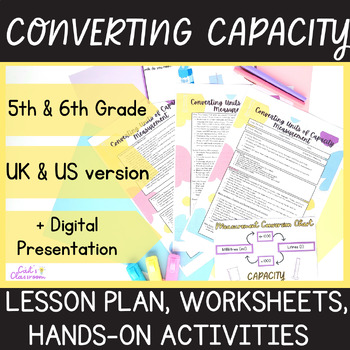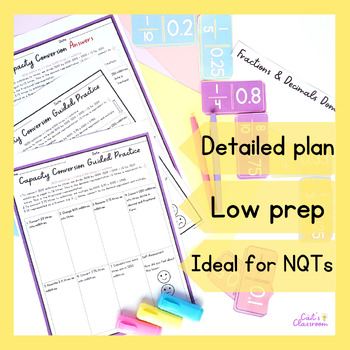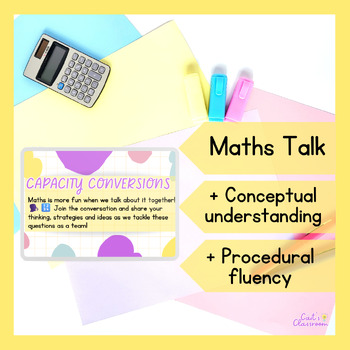Converting Capacity│Lesson Plan, Hands-on Game & Worksheets│5th/6th Grade Math
- Zip
Also included in
- 5th/6th grade end of year math fun! Looking for a complete unit on liquid volume and capacity measured in liters and milliliters? Want it to include step-by-step lesson plans, hands-on measurement activities, digital presentations/software, engaging games and practice worksheets? Then this resourcePrice $18.00Original Price $25.75Save $7.75
- 5th/6th grade end of year math fun! Preparing to teach metric weight and capacity? From liters and milliliters to tons and kilograms, this unit features hands-on measurement games/activities, digital/printable resources and detailed lesson plans.Designed specifically with newly qualified teachers inPrice $29.70Original Price $45.68Save $15.98
Description
Looking for a fun, engaging lesson for fifth/sixth grade on converting between liters and milliliters? Want it to include a hands-on warm-up game, guided practice worksheets, a digital presentation and real-world problem solving scenarios? Then this resource is for ✨️YOU!✨️
Take the stress out of creating complete lesson plans and resources! This lesson includes a fractions and decimals domino game, a main activity on converting between liters and milliliters in decimal and fractional form, problem solving scenarios to consolidate key learning and a digital presentation promoting math talk in the classroom.
This resource includes UK and US spellings and is also aligned with both CCSSM and the Irish Primary Mathematics Curriculum (2023) for seamless integration into planning documents ✏️.
Help your students excel in math while reclaiming your valuable downtime with this engaging, curriculum-aligned lesson plan. Grab your copy TODAY!
⭐️Benefits⭐️
✅️Reduces planning demands on teachers, saving valuable time and effort while being well-designed and aligned with curriculum standards.
✅️Offers a complete, print-and-go resource with step-by-step instructions, ideal for newly qualified teachers who want support teaching math to the senior grades.
✅️Enhances conceptual understanding and procedural fluency in converting between liters and milliliters.
⭐️In Depth Description⭐️
This 45-minute lesson plan includes:
✅ Equivalent fractions & decimals dominoes game (24 dominoes) - Reinforces understanding of equivalent fractions and decimals, promoting retention and application of conversion concepts.
✅ 2 capacity conversion charts (colour and black & white) - Provides visual reference tools for easily converting between different units of capacity, aiding in comprehension and accuracy.
✅ Capacity conversion guided practice worksheet & answer key (colour and black & white) - Offers structured practice exercises for applying capacity conversion skills.
✅ 6 problem solving scenarios & answer key - Challenges students to apply capacity conversion concepts to real-world situations, fostering critical thinking and problem-solving skills.
✅ Problem solving worksheet (colour and black & white) - Provides opportunities for students to record their thinking, reinforcing understanding and promoting application of learned concepts.
✅️Math Talk digital presentation: Provides a clear focus for math discussions, encouraging student participation and collaboration.
✅️3 learning objectives: Clearly defines lesson outcomes, guiding both teachers and students in their learning goals.
✅️Differentiation strategies: Accommodates diverse learning needs, ensuring all students can access and succeed in the lesson.
✅️Assessment strategies: Provides practical guidance on assessing student understanding throughout the lesson.
✅️Key vocabulary and definitions: Equips students with essential language for effective communication about capacity concepts.
✅️Exit tickets (colour and black & white): Quickly gauges student understanding at the end of the lesson, providing valuable feedback for future instruction.
✅️ Explicit links to the new Primary Mathematics Curriculum (2023),specifically the element of understanding and connecting and the competencies of being mathematical, being an active citizen and being a communicator and using language.
✅️Common Core aligned - CSS.MP.1, CCSS.5.MD.A.1
⭐️Other Uses⭐️
- Math Centers: Utilize the dominoes game and guided practice worksheets as interactive math center activities to reinforce conversion skills in a small group setting.
- Homework Extensions: Assign the problem-solving scenarios and worksheets as homework tasks to provide students with additional practice and consolidate their understanding beyond the classroom.
- Review Sessions: Use the digital presentation and problem-solving scenarios during review sessions before assessments to revisit key concepts and prepare students for upcoming evaluations.
➡️ Don't let this opportunity slip away! Elevate your teaching experience and engage your students - secure your complete lesson plan and resources TODAY! ⬅️
Click here to join the Cáit's Classroom mailing list for valuable tips, tricks, and special offers designed to support newly qualified teachers in effectively teaching maths to 3rd-6th class students.
Related Products
⭐ Capacity & Liquid Volume│Math Lesson Plan Hands-on Activities Worksheets│5th/6th
⭐ Comparing Capacity│Lesson Plan,Hands-on Activities,Worksheets│5th/6th Grade Math
⭐ Increasing Liquid Volume Lesson Plan│Excel/Sheets Activity│5th/6th Grade Math
⭐ Liquid Volume & Capacity │5-Day Unit│Lessons Worksheets Games Activities 5th/6th
⭐ Math Lesson Plan │Units of Capacity Hands-On Activities/Worksheets│5th/6th Grade







